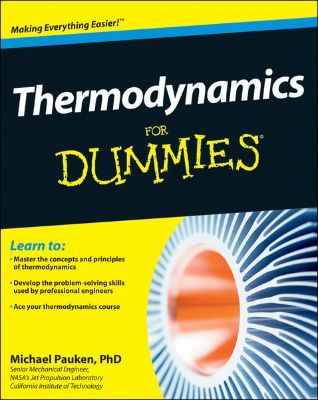
Lýsing:
Thermodynamics For Dummies tracks to a typical thermodynamics course offered at the undergraduate level and assists readers in understanding the fundamental concepts of the subject and helps to develop problem-solving skills through practice in solving energy-related problems. Specific coverage includes: General balance principle (open systems, closed systems, rate balances, increment balances) Mass balances (specific volume, system mass, mass-flow rate) Zeroth law (thermodynamic equilibrium and temperature) First-law balances (internal energy, enthalpy) Second-law balances (availability, entropy) Cycles (Rankine, Brayton, vapor-compression) Non-reacting mixtures of ideal gases Reacting mixtures (mass balances, energy balances, heating values, standardized enthalpy).
Annað
- Höfundur: Mike Pauken
- Útgáfa:1
- Útgáfudagur: 2011-07-12
- Hægt að prenta út 2 bls.
- Hægt að afrita 10 bls.
- Format:ePub
- ISBN 13: 9781118120989
- Print ISBN: 9781118002919
- ISBN 10: 1118120981
Efnisyfirlit
- Introduction
- About This Book
- Conventions Used in This Book
- What You’re Not to Read
- Foolish Assumptions
- How This Book Is Organized
- Part I: Covering the Basics in Thermodynamics
- Part II: Employing the Laws of Thermodynamics
- Part III: Planes, Trains, and Automobiles: Making Heat Work for You
- Part IV: Handling Thermodynamic Relationships, Reactions, and Mixtures
- Part V: The Part of Tens
- Icons Used in This Book
- Where to Go from Here
- Part I: Covering the Basics in Thermodynamics
- Chapter 1: Thermodynamics in Everyday Life
- Grasping Thermodynamics
- Examining Energy’s Changing Forms
- Kinetic energy
- Potential energy
- Internal energy
- Watching Energy and Work in Action
- Engines: Letting energy do work
- Refrigeration: Letting work move heat
- Getting into Real Gases, Gas Mixtures, and Combustion Reactions
- Discovering Old Names and New Ways of Saving Energy
- Chapter 2: Laying the Foundation of Thermodynamics
- Defining Important Thermodynamic Properties
- Eyeing general measurement basics
- Mass
- Pressure
- Temperature
- Density
- Energy
- Enthalpy
- Specific heat
- Entropy
- Understanding Thermodynamic Processes
- Creating a path for a process
- Finding the state at each end of a path: The state postulate
- Connecting processes to make a cycle
- Discovering Nature’s Law and Order on Temperature, Energy, and Entropy
- The zeroth law on temperature
- The first law on energy conservation
- The second law on entropy
- The third law on absolute zero
- Defining Important Thermodynamic Properties
- Chapter 1: Thermodynamics in Everyday Life
- Chapter 3: Working with Phases and Properties of Substances
- It’s Just a Phase: Describing Solids, Liquids, and Gases
- The phase diagram
- The T-v diagram
- The P-v diagram
- Knowing How Phase Changes Occur
- From compressed liquid to saturated liquid
- From saturated liquid to saturated vapor
- From saturated vapor to superheated vapor
- Finding Thermodynamic Properties from Tables
- Figuring out linear interpolation
- Interpolating with two variables
- Good Gases Have Ideal Behavior
- It’s Just a Phase: Describing Solids, Liquids, and Gases
- Chapter 4: Work and Heat Go Together Like Macaroni and Cheese
- Work Can Do Great Things
- Working with springs
- Turning a shaft
- Accelerating a car
- Moving with pistons
- Figuring out boundary work
- Heating Things Up, Cooling Things Down
- Getting hot with boilers
- Cooling off with condensers
- Chilling with evaporators
- Work Can Do Great Things
- Chapter 5: Using the First Law in Closed Systems
- Conserving Mass in a Closed System
- Balancing Energy in a Closed System
- Applying the First Law to Ideal-Gas Processes
- Working with constant volume
- Working with constant pressure
- Working with constant temperature
- Working with an adiabatic process
- Applying the First Law to Processes with Liquids and Solids
- Chapter 6: Using the First Law in Open Systems
- Conserving Mass in an Open System
- Defining mass and volumetric flow rates
- Applying conservation of mass to a system
- Balancing Mass and Energy in a System
- When Time Stands Still: The Steady State Process
- Using the First Law on Four Common Open-System Processes
- Flowing through nozzles and diffusers
- Working with pumps, compressors, and turbines
- Moving energy with heat exchangers
- Reducing pressure with throttling valves
- When Time Is of the Essence: The Transient Process
- Making assumptions for the energy balance
- Analyzing a transient process
- Conserving Mass in an Open System
- Looking at the Impact of the Second Law
- Defining Thermal Energy Reservoirs
- Parameters of a thermal reservoir
- Considering highs and lows
- Working with the Kelvin-Planck Statement on Heat Engines
- Characterizing heat engines
- Determining thermal efficiency
- Chilling with the Clausius Statement on Refrigeration
- Characterizing refrigerators
- Finding the coefficient of performance
- What Is Entropy?
- Taking a microscopic view of entropy
- Looking at entropy on a macroscopic level
- Coping with the Increase in Entropy Principle
- Working with T-s Diagrams
- Using T-ds Relationships
- Calculating Entropy Change
- For pure substances
- For liquids and solids
- For ideal gases
- Analyzing Isentropic Processes
- Using constant specific heat
- Using relative pressure and relative volume
- Balancing Entropy in a System
- Measuring Work Potential with Energy Availability
- Determining the Change in Availability
- Calculating availability in closed systems
- Calculating availability in open systems with steady flow
- Calculating availability in open systems with transient flow
- Balancing the Availability of a System
- Transferring availability using work processes
- Transferring availability with heat transfer processes
- Transferring availability with mass flow
- Understanding the Decrease in Availability Principle
- Figuring Out Reversible Work and Irreversibility
- Calculating the Second-Law Efficiency of a System
- Chapter 10: Working with Carnot and Brayton Cycles
- Analyzing the Ideal Heat Engine: The Carnot Cycle
- Examining the four processes in a Carnot cycle
- Calculating Carnot efficiency
- Working with the Ideal Gas Turbine Engine: The Brayton Cycle
- Examining the four processes in a Brayton cycle
- Analyzing the Brayton cycle
- Determining Brayton cycle efficiency
- Calculating Brayton cycle irreversibility
- Improving the Brayton Cycle with Regeneration
- Adding Intercooling and Reheating to the Brayton Cycle
- Looking at how intercooling and reheating affect the Brayton cycle
- Analyzing the effects of intercooling and reheating
- Deviating from Ideal Behavior: Actual Brayton Cycle Performance
- Flying the Brayton Cycle in Jet Propulsion
- Seeing what happens in an ideal turbojet cycle
- Analyzing the jet engine cycle
- Analyzing the Ideal Heat Engine: The Carnot Cycle
- Understanding the Basics of Reciprocating Engines
- Working with the Ideal Spark Ignition Engine: The Otto Cycle
- Analyzing the Otto cycle
- Calculating Otto cycle efficiency
- Calculating Otto cycle irreversibility
- Working with the Ideal Compression Ignition Engine: The Diesel Cycle
- Examining the four processes in a diesel cycle
- Analyzing the Diesel cycle
- Calculating diesel cycle efficiency
- Calculating diesel cycle irreversibility
- Understanding the Basics of the Rankine Cycle
- Examining the Four Processes of the Rankine Cycle
- Analyzing the Cycle Using Steam Tables
- Calculating Rankine cycle efficiency
- Calculating Rankine cycle irreversibility
- Improving the Rankine Cycle with Reheat
- Improving the Rankine Cycle with Regeneration
- Deviating from Ideal Behavior: Actual Rankine Cycle Performance
- Understanding the Basics of Refrigeration Cycles
- Chilling with the Reverse Brayton Cycle
- Examining the four processes of the reverse Brayton cycle
- Analyzing the cycle with constant specific heat
- Calculating the reverse Brayton cycle coefficient of performance
- Calculating irreversibility for Brayton’s refrigerator
- Cooling with the Vapor-Compression Refrigerator
- Examining the four processes in a vapor-compression refrigerator
- Analyzing the cycle with refrigerant property tables
- Calculating the vapor-compression refrigerator coefficient of performance
- Calculating vapor-compression refrigerator irreversibility
- Warming Up with Heat Pumps
- Examining the four processes in a heat pump
- Analyzing a heat pump
- Calculating the heat pump coefficient of performance
- Calculating heat pump irreversibility
- Chapter 14: Understanding the Behavior of Real Gases
- Deviating from Ideal-Gas Behavior: Real-Gas Behavior
- Determining Properties with the Compressibility Factor
- Using reduced temperature and pressure
- Using pseudo-reduced volume
- Finding Pressure with van der Waals
- Chapter 15: Mixing Gases That Don’t React with Each Other
- Determining Thermodynamic Properties for a Mixture of Gases
- Using mass and molar fractions for gas mixtures
- Finding properties of a gas mixture
- Getting the Compressibility Factor for Real-Gas Mixtures
- Making assumptions for mixture compressibility factors
- Finding compressibility factors with Amagat’s law
- Finding compressibility factors with Dalton’s law
- Calculating compressibility factors with Kay’s Rule
- Working with Psychrometrics: Air and Water Vapor Mixtures
- Finding the wet-bulb temperature with a sling psychrometer
- It’s muggy out there: Calculating specific and relative humidity
- My glasses are fogging up: Defining the dew point
- Working out problems with temperature and humidity
- Using the psychrometric chart
- Making Life Comfortable with Air Conditioning
- Heating and humidifying the air
- Cooling and dehumidifying the air
- Determining Thermodynamic Properties for a Mixture of Gases
- Forming Combustion Reaction Equations
- Figuring out how much air you need: Writing stoichiometric reaction equations
- Accounting for excess air in combustion
- Defining Combustion-Related Thermodynamic Properties
- Enthalpy of formation
- Enthalpy of combustion
- Using the First Law of Thermodynamics on Steady-Flow Combustion Systems
- Analyzing an Example Steady-Flow System
- Using the First Law of Thermodynamics on Closed Combustion Systems
- Analyzing an Example Closed System
- Ouch! That’s Hot: Determining the Adiabatic Flame Temperature
- Figuring Out an Example Adiabatic Flame Temperature
- Chapter 17: Ten Famous Names in Thermodynamics
- George Brayton
- Nicolas Léonard Sadi Carnot
- Anders Celsius
- Rudolf Diesel
- Daniel Gabriel Fahrenheit
- James Prescott Joule
- Nikolaus August Otto
- William John Macquorn Rankine
- William Thomson or Lord Kelvin
- James Watt
- Chapter 18: Ten More Cycles of Note
- Two-Stroke Engines
- Wankel Engines
- The Stirling Cycle
- The Ericsson Cycle
- The Atkinson Cycle
- The Miller Cycle
- The Absorption Cycle
- The Einstein Cycle
- Combined-Cycle Engines
- Binary Vapor Cycles
UM RAFBÆKUR Á HEIMKAUP.IS
Bókahillan þín er þitt svæði og þar eru bækurnar þínar geymdar. Þú kemst í bókahilluna þína hvar og hvenær sem er í tölvu eða snjalltæki. Einfalt og þægilegt!Rafbók til eignar
Rafbók til eignar þarf að hlaða niður á þau tæki sem þú vilt nota innan eins árs frá því bókin er keypt.
Þú kemst í bækurnar hvar sem er
Þú getur nálgast allar raf(skóla)bækurnar þínar á einu augabragði, hvar og hvenær sem er í bókahillunni þinni. Engin taska, enginn kyndill og ekkert vesen (hvað þá yfirvigt).
Auðvelt að fletta og leita
Þú getur flakkað milli síðna og kafla eins og þér hentar best og farið beint í ákveðna kafla úr efnisyfirlitinu. Í leitinni finnur þú orð, kafla eða síður í einum smelli.
Glósur og yfirstrikanir
Þú getur auðkennt textabrot með mismunandi litum og skrifað glósur að vild í rafbókina. Þú getur jafnvel séð glósur og yfirstrikanir hjá bekkjarsystkinum og kennara ef þeir leyfa það. Allt á einum stað.
Hvað viltu sjá? / Þú ræður hvernig síðan lítur út
Þú lagar síðuna að þínum þörfum. Stækkaðu eða minnkaðu myndir og texta með multi-level zoom til að sjá síðuna eins og þér hentar best í þínu námi.
Fleiri góðir kostir
- Þú getur prentað síður úr bókinni (innan þeirra marka sem útgefandinn setur)
- Möguleiki á tengingu við annað stafrænt og gagnvirkt efni, svo sem myndbönd eða spurningar úr efninu
- Auðvelt að afrita og líma efni/texta fyrir t.d. heimaverkefni eða ritgerðir
- Styður tækni sem hjálpar nemendum með sjón- eða heyrnarskerðingu
- Gerð : 208
- Höfundur : 10747
- Útgáfuár : 2011
- Leyfi : 380


